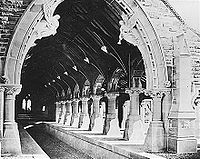
Rookwood Cemetery railway line, Sydney
Encyclopedia

CityRail
CityRail is an operating brand of RailCorp, a corporation owned by the state government of New South Wales, Australia. It is responsible for providing commuter rail services, and some coach services, in and around Sydney, Newcastle and Wollongong, the three largest cities of New South Wales. It is...
. The line serviced Rookwood Cemetery
Rookwood Cemetery
Rookwood Cemetery is the largest multicultural necropolis in the Southern Hemisphere, located in Sydney, New South Wales, Australia...
and was built in 1864, opening on 22 October 1864.
With the closure of the Town Hall and Devonshire Cemeteries by the mid-19th century and an ever increasing population, a decision was made to purchase a huge area of land (250 acres) in 1862 to establish the Necropolis at Haslem's Creek in 1867. The term Necropolis
Necropolis
A necropolis is a large cemetery or burial ground, usually including structural tombs. The word comes from the Greek νεκρόπολις - nekropolis, literally meaning "city of the dead"...
comes from the Greek 'nekropolis' or 'City of the Dead'.
As this location was some distance from the centre of Sydney and from the main-line train station at Haslem's Creek, it was considered necessary to establish a railway station at the centre of the cemetery. This line would run as a spur line from the existing station at Haslem's creek and allow easier movement into and out of the cemetery. The railway line construction began in November 1864 and from 1 January 1865 trains began their run into the cemetery. However, The Sydney Morning Herald advertised the first regular services from 1 April 1867. The times advertised were for services at 8.30am and 4.15pm. Later this was changed to 9.15am and 3pm. It stopped at prearranged stations on the journey from central Sydney in order to pick up mourners and coffins. Some stations, such as Newtown
Newtown
-Australia:*Newtown, New South Wales*Newtown, Queensland *Newtown, Queensland *Newtown, Victoria, a suburb of Geelong*Newtown, Victoria , a locality near Ballarat-Ireland:* Newtown, County Cork* Newtown, County Laois...
had special platform areas and buildings reserved for mourners and coffins.

The last trains that ran funeral processions all but ceased in the late 1930s. Following this they were only used for visitors on Sundays and Mother's Day. The service was briefly revived during World War II
World War II
World War II, or the Second World War , was a global conflict lasting from 1939 to 1945, involving most of the world's nations—including all of the great powers—eventually forming two opposing military alliances: the Allies and the Axis...
during petrol rationing. The last railway timetable was recorded in 1947 and read Sydney 2.17pm to Strathfield 2.33pm to Rookwood #1, 2.50pm.
On 3 April 1948 the service was officially terminated and the rails were pulled up. The spur was recorded as closed on 29 December 1948.
Rookwood Cemetery line stations
Station names are based on the current name of the station, or the name of the station when it was closed.- Regent Street
- Cemetery Station No. 1
- Cemetery Station No. 2
- Cemetery Station No. 3
- Cemetery Station No. 4
Additional reading
The Rookwood Cemetery Line Singleton, C.C. Australian Railway Historical Society BulletinAustralian Railway History
Australian Railway History , is the premier magazine covering railway history in Australia...
, February, 1960 pp17–28

